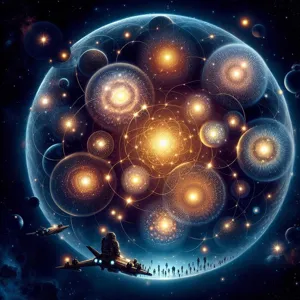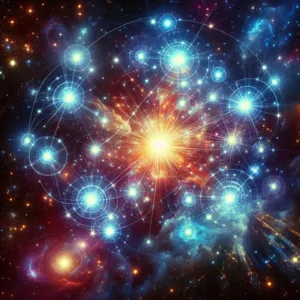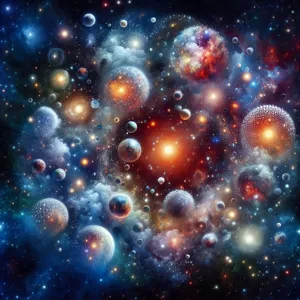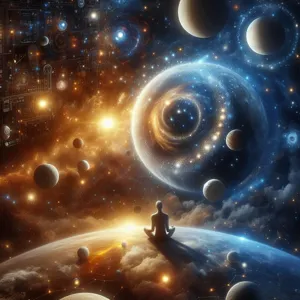The universe, vast and enigmatic, is a treasure trove of celestial wonders just waiting to be explored.
Among its many marvels, star clusters stand out as breathtaking assemblies of stars that illuminate the night sky and spark our curiosity about the cosmos. These luminous congregations vary widely in their formation, age, and composition, each offering a unique glimpse into the life cycle of stars and the dynamic processes that govern our universe. In this blog post, we will embark on a journey through the cosmos to unravel the mysteries of the different types of star clusters—globular and open clusters—and their significance in the grand tapestry of astronomy. From the tightly packed, ancient spheres of globular clusters that hold secrets of the universe’s early days, to the more youthful and loosely bound open clusters that inspire wonder, join us as we delve into the fascinating world of star clusters and discover what they can teach us about our place in the universe.
1. Introduction to Star Clusters: What Are They?

Star clusters are some of the most fascinating celestial formations in our universe, acting as stellar nurseries and communities that reveal the intricate processes of star formation and evolution. But what exactly are star clusters? In essence, they are groups of stars that are gravitationally bound to one another, forming a cohesive unit that can range from a few dozen to thousands of stars. These clusters come in two primary varieties: globular clusters and open clusters, each offering a unique glimpse into the life cycle of stars.
Globular clusters are spherical collections of stars that orbit the core of a galaxy. They are densely packed and typically contain older stars, giving them a distinctive yellowish hue. These clusters can be found in the halo of galaxies, like a sparkling crown of jewels surrounding a vast expanse of darkness. On the other hand, open clusters are looser collections of stars that are generally younger and found within the galactic plane. They tend to exhibit a more chaotic arrangement, with stars scattered across a larger volume of space, often showcasing vibrant colors indicative of their youthful energy.
Understanding star clusters is crucial for astronomers, as they serve as natural laboratories for studying the formation and evolution of stars. They allow scientists to observe how stars interact, how they age, and the effects of gravitational forces over time. By examining the characteristics of various star clusters, we gain valuable insights into the history of our galaxy and the broader cosmos. As we embark on this exploration of star clusters, we will delve deeper into their types, formation processes, and the key roles they play in our understanding of the universe.
2. The Importance of Studying Star Clusters
Studying star clusters is crucial for a multitude of reasons, as these celestial formations serve as invaluable laboratories for understanding the universe. Star clusters, which are groups of stars bound together by gravity, provide unique insights into stellar evolution, galactic dynamics, and the formation of the universe itself.
Firstly, star clusters come in two main varieties: open clusters and globular clusters, each offering distinct perspectives on the lifecycle of stars. Open clusters, characterized by their loose, irregular shape, contain younger stars that are still in the process of evolving. By observing these young stars, astronomers can glean information about star formation processes and the chemical composition of the interstellar medium from which they originated. In contrast, globular clusters are densely packed collections of older stars, often containing some of the universe’s oldest stellar populations. Studying these ancient stars allows scientists to probe the history of the galaxy and understand the conditions that prevailed in the early universe.
Moreover, star clusters serve as essential benchmarks for distance measurement in the cosmos. Their luminosity can be relatively predictable, making them excellent candidates for establishing the cosmic distance ladder. By accurately determining the distances to star clusters, astronomers can refine their measurements of other celestial objects, which is vital for understanding the scale and structure of the universe.
Additionally, the study of star clusters contributes to our knowledge of dark matter and the gravitational forces that influence galaxy formation. The dynamics of star clusters can reveal information about the distribution of dark matter in our galaxy and beyond, shedding light on one of the universe’s greatest mysteries.
In essence, exploring star clusters is not merely an academic exercise; it is a gateway to unraveling the complex tapestry of the cosmos. By delving into the intricacies of these stellar groupings, we uncover the fundamental processes that govern the evolution of stars, galaxies, and the universe itself, ultimately enriching our understanding of our place in the vast expanse of space.
3. Overview of the Types of Star Clusters

When we gaze up at the night sky, we often marvel at the countless stars twinkling above us. Among these celestial wonders, star clusters stand out as remarkable formations, each with its unique characteristics and stories. Star clusters are generally classified into two primary types: open clusters and globular clusters, each offering a glimpse into the intricate tapestry of our universe.
**Open Clusters** are relatively young, loosely bound groups of stars that often contain just a few dozen to a few thousand members. These clusters are typically found in the galactic plane and are associated with regions of active star formation. The stars in open clusters are generally similar in age and composition, illuminating the beauty of stellar birth and evolution. Well-known examples include the Pleiades and the Hyades, both situated in the constellation Taurus. The stars in these clusters can be easily distinguished, often exhibiting a bluish hue, a reminder of their youthful energy and relative closeness in cosmic terms.
In contrast, **Globular Clusters** are ancient, densely packed collections of stars, numbering in the tens of thousands to millions. These clusters are spherical in shape and orbit the core of galaxies, often residing in the halo surrounding the galactic center. The stars in globular clusters are typically older, with many being over 10 billion years old, which gives them a yellowish or reddish tint due to their cooler temperatures. Iconic globular clusters like M13 in the constellation Hercules and Omega Centauri showcase mesmerizing views of tightly packed stars, creating a stunning celestial dance that has fascinated astronomers for centuries.
Understanding the differences between open and globular clusters not only enhances our appreciation of the cosmos but also sheds light on the processes that govern star formation and evolution. By exploring these clusters, we gain valuable insights into the history and structure of our galaxy, as well as the universe at large. Each cluster, whether young and vibrant or ancient and serene, holds secrets waiting to be uncovered, inviting us to continue our journey of discovery among the stars.
4. Open Star Clusters: Characteristics and Examples
Open star clusters are among the most fascinating celestial formations in our universe, illuminating the night sky with their youthful vibrancy. These clusters typically consist of a relatively small number of stars—usually ranging from just a few dozen to a few thousand—bound together by mutual gravitational attraction. One of the defining characteristics of open star clusters is their loose and irregular structure, which allows for a more dynamic and less homogeneous appearance compared to their globular counterparts.
Open clusters are primarily composed of young stars that have recently formed from the same molecular cloud. This shared origin means that the stars within an open cluster often exhibit similar chemical compositions and ages, typically ranging from a few million to a few hundred million years old. This youthfulness contributes to their bright, bluish colors, as many of the stars are still in the early stages of stellar evolution, often burning hydrogen in their cores at a much faster rate than older stars.
One of the most famous examples of an open star cluster is the Pleiades, also known as the Seven Sisters, which is easily visible to the naked eye in the constellation Taurus. This stunning cluster features several bright blue stars, surrounded by a faint haze of nebulosity. Another notable open cluster is the Hyades, also located in Taurus, which is notable for its V-shaped arrangement of stars and is the closest open cluster to Earth.
The beauty of open star clusters is not just in their formation but also in their role within the broader cosmos. As these clusters age, they gradually disperse, with their stars drifting away over time. This process contributes to the continual evolution of our galaxy, as the stars from these clusters will eventually find new homes among the vast expanse of space. By studying open star clusters, astronomers gain valuable insights into the lifecycle of stars, the dynamics of stellar formation, and the intricate tapestry of our universe.
5. Globular Star Clusters: Structure and Formation

Globular star clusters are some of the most fascinating structures in the universe, captivating astronomers and stargazers alike with their dense collections of stars. These clusters are typically spherical in shape and contain hundreds of thousands, or even millions, of stars tightly packed together in a relatively small volume of space. Their remarkable density is a testament to the gravitational forces at play, as each star is held in orbit around a common center of mass, creating a mesmerizing tapestry of stellar light.
The formation of globular star clusters is a complex process that continues to intrigue scientists. It is believed that they formed early in the universe’s history, shortly after the Big Bang, around 10 to 13 billion years ago. During this primordial era, regions of gas and dark matter began to collapse under their own gravity, leading to the birth of stars. Over time, these stars congregated into clusters, forming the dense, spherical structures we observe today. Their age and formation processes provide essential insights into the early conditions of the universe and the formation of galaxies.
Globular clusters are often found in the halos of galaxies, orbiting far from the galactic center. They are generally older than their more chaotic counterparts, the open clusters, which are younger, less densely packed, and tend to form in the spiral arms of galaxies. The stars in globular clusters are typically older and have lower metallicities, meaning they contain fewer elements heavier than hydrogen and helium. This characteristic indicates that they were formed in the early universe, long before supernovae spread heavier elements into the cosmos.
As we explore these ancient celestial bodies, we gain a deeper understanding of stellar evolution and the dynamics of galaxies. Observations of globular clusters can reveal important information about the life cycles of stars, stellar dynamics, and even the presence of dark matter. With ongoing advancements in telescope technology and observational techniques, astronomers continue to study these clusters, peeling back the layers of cosmic history they hold. Each globular cluster serves as a time capsule, offering a glimpse into the universe’s formative years and reminding us of our place within the vastness of space.
6. Superclusters: The Largest Structures in the Universe
Superclusters are the grand titans of the cosmic landscape, towering formations that dwarf even the mightiest galaxies. These colossal structures consist of hundreds to thousands of galaxies bound together by gravity, extending over hundreds of millions of light-years. They represent the largest known structures in the universe, illuminating the complex web of cosmic architecture that extends far beyond our home galaxy, the Milky Way.
A supercluster is often made up of smaller clusters and groups of galaxies, forming intricate patterns that resemble the veins of a leaf or the branches of a tree. One of the most well-known superclusters is the Laniakea Supercluster, which is home to our own Milky Way. This immense structure contains over 100,000 galaxies, all interconnected through a vast network of dark matter and gravitational forces, showcasing the breathtaking scale of the universe.
The formation of superclusters began with the aftermath of the Big Bang, when matter began to clump together under the influence of gravity. Over billions of years, these clumps grew larger and larger, eventually coalescing into the superclusters we observe today. The study of these colossal formations not only helps astronomers understand the distribution of matter in the universe but also provides insights into its evolution and the forces that shape it.
Superclusters are often found in regions of the universe where galaxies are densely packed, creating an environment ripe for cosmic interactions. The relationships between galaxies within a supercluster can lead to fascinating phenomena, such as galaxy collisions and mergers, which further contribute to the dynamic nature of the cosmos. As we delve deeper into the mysteries of superclusters, we uncover not just the structure of the universe, but also the intricate dance of cosmic evolution, revealing the interconnectedness of all celestial bodies.
Understanding superclusters is vital for comprehending the larger-scale structure of the universe and the forces at play within it. As we continue our exploration of the cosmos, these magnificent structures remind us of the vastness and complexity of the universe we inhabit.
7. Associations: Young Stars in Groups

When we delve into the realm of star clusters, associations present a captivating chapter in the cosmic narrative. Unlike their older counterparts, globular and open clusters, associations are characterized by their youth and dynamism, typically comprising relatively young stars, often just a few million years old. These stellar groups, loosely bound by gravity, can contain dozens to thousands of stars, all sharing a common birthplace within vast molecular clouds.
One of the most fascinating aspects of associations is their transient nature. As young stars burst forth from their stellar nurseries, they are often surrounded by residual gas and dust, remnants of the molecular clouds from which they formed. This not only adds a visual richness to the region but also highlights the ongoing processes of star formation. Because these stars are still in the early stages of their life cycles, they exhibit a wide variety of characteristics, from bright blue supergiants to more modestly luminous stars, all shining brightly against the darkness of space.
Associations are often categorized into two primary types: OB associations and T associations. OB associations are named after the hot, massive O and B-type stars that dominate their composition, radiating intense energy and shaping their environment through stellar winds and supernova events. In contrast, T associations are named for T Tauri stars, which are lower-mass stars in the early stages of development, characterized by their erratic brightness and strong stellar winds.
As we explore these stellar groups, we uncover not just the beauty of their formations but also gain insights into the life cycles of stars and the evolution of galaxies. By studying associations, astronomers can piece together the complex puzzle of star formation and the intricate web of interactions that define our universe. Each association serves as a unique laboratory, allowing researchers to examine the conditions that foster star birth and the eventual fate of these celestial bodies as they continue their journey through time and space.
8. The Role of Star Clusters in Galactic Evolution
Star clusters play a crucial role in the tapestry of galactic evolution, serving as both laboratories for astrophysical processes and indicators of the history and dynamics of galaxies. These stellar groupings, whether they are globular or open clusters, provide astronomers with invaluable insights into the formation and lifecycle of stars, as well as the broader evolution of galaxies themselves.
Globular clusters, dense collections of stars that orbit the galactic core, are some of the oldest structures in the universe, often containing stars that formed billions of years ago. Their study allows scientists to trace the early epochs of galaxy formation and understand how the first generations of stars contributed to the chemical enrichment of the universe. By analyzing the age and composition of stars within these clusters, researchers can infer the conditions of the early cosmos and how these early stars influenced the formation of subsequent generations.
On the other hand, open clusters, which are more loosely bound and contain younger stars, reveal insights into ongoing star formation processes. These clusters are often found in the spiral arms of galaxies, where gas and dust are abundant. By studying open clusters, astronomers can investigate the environmental factors that lead to star formation and gain a deeper understanding of the dynamics of galactic evolution, including how new stars are continuously born within the vast expanse of space.
Moreover, star clusters can impact their surrounding environments through processes such as supernova explosions and stellar winds, influencing the interstellar medium and triggering new waves of star formation. The intricate dance between clusters and their galactic hosts illustrates the interconnectedness of cosmic structures and emphasizes the importance of star clusters in the grand narrative of the universe.
In essence, star clusters are not just collections of stars; they are pivotal players in the cosmic drama of galactic evolution. By studying these celestial formations, we unlock the secrets of the universe’s past and present, piecing together the story of how galaxies, including our own Milky Way, have evolved over billions of years.
9. Techniques for Observing and Identifying Star Clusters
Observing and identifying star clusters can be a rewarding experience, whether you’re a seasoned astronomer or a curious beginner gazing up at the night sky. Different techniques can enhance your ability to locate and appreciate these celestial formations, each offering unique insights into their structures and compositions.
One of the most accessible methods for beginners is using binoculars. Unlike telescopes, which can be bulky and complex, binoculars are portable and easy to handle. They allow you to scan the night sky and spot star clusters with relative ease. Look for clusters like the Pleiades, also known as the Seven Sisters, which are bright and easily recognizable even with a modest pair of binoculars. As you gaze through the lenses, you’ll notice the clusters’ stars twinkling against the black backdrop of space, revealing their breathtaking beauty.
For those ready to delve deeper, a telescope can unlock a more detailed view of star clusters. A small to medium-sized telescope can help you distinguish individual stars within clusters, allowing you to appreciate the varying colors and brightness that give them character. The globular cluster M13 in the constellation Hercules, for instance, appears as a dense ball of stars through a telescope, showcasing its intricate structure and the vast number of stars it contains.
Digital tools have also revolutionized the way we observe star clusters. With smartphone apps that map the night sky, stargazers can identify constellations and their respective clusters with ease. These apps often include augmented reality features, allowing you to hold your phone up to the sky and see the names of stars and clusters superimposed on your view, making identification a breeze.
Finally, attending local astronomy clubs or star parties can provide invaluable hands-on experience. Experienced astronomers often share their telescopes and expertise, guiding newcomers in identifying various star clusters. These gatherings also foster a sense of community among stargazers, encouraging shared knowledge and a deeper appreciation for the cosmos.
Incorporating these techniques into your stargazing routine will not only enhance your observational skills but also deepen your connection to the wonders of the universe. By honing your ability to identify star clusters, you’ll find that the night sky is filled with stories waiting to be uncovered, each cluster a testament to the vastness and beauty of our cosmic surroundings.
10. The Lifecycle of Star Clusters: Birth, Evolution, and Death
The lifecycle of star clusters is a fascinating journey that spans millions to billions of years, showcasing the dynamic processes that govern the cosmos. These clusters, whether globular or open, undergo significant changes from their inception to their eventual demise, reflecting the complex interplay of stellar evolution and gravitational forces.
**Birth:** The life of a star cluster begins in the densest regions of molecular clouds, where gas and dust coalesce under gravity’s influence. As the material collapses, it fragments into smaller clumps, each giving birth to new stars. This process, known as star formation, occurs in a flurry of activity, with hundreds or even thousands of stars emerging in a relatively short period. In open clusters, for example, young, hot stars illuminate their surroundings, creating a breathtaking tapestry of light. In contrast, globular clusters form in the early universe, consisting of some of the oldest stars, which have long since exhausted their nuclear fuel.
**Evolution:** Once formed, star clusters embark on a journey of evolution influenced by their environment and the gravitational interactions among their stars. Open clusters, often found in the spiral arms of galaxies, gradually disperse over time due to their lower gravitational binding. The stars within these clusters can drift apart, leading to a diverse scattering across the galaxy. In contrast, globular clusters exhibit a tighter gravitational hold, allowing them to maintain their structure for billions of years. As the stars evolve, they undergo transformations, such as expanding into red giants or ending their lives in spectacular supernovae, contributing to the enrichment of the interstellar medium with heavy elements.
**Death:** The end of a star cluster’s life can vary dramatically between the two types. Open clusters typically dissolve over a timescale of tens to hundreds of millions of years, their stars becoming part of the galactic halo. In contrast, globular clusters can persist for much longer, often outliving the galaxies they inhabit. Eventually, however, even these ancient clusters succumb to the relentless forces of time. They may be consumed by the gravitational pull of nearby galaxies, leading to their gradual disintegration. As they fade away, they leave behind a legacy of star remnants, like white dwarfs, neutron stars, and black holes, which continue to enrich the cosmos.
Understanding the lifecycle of star clusters not only provides insight into the birth and death of stars but also reveals the intricate evolution of galaxies themselves. Each cluster serves as a cosmic time capsule, holding clues about the universe’s history, the formation of elements, and the forces that shape the very fabric of space. Exploring these extraordinary clusters invites us to ponder our place in the universe and the stories written in the stars.
11. Famous Star Clusters and Their Significance
Star clusters are not just celestial formations; they are the cosmic jewels that adorn our night sky, each with its own story and significance. Among the most famous star clusters, the Pleiades, also known as the Seven Sisters, captivates stargazers with its striking beauty. Located approximately 440 light-years away in the constellation Taurus, this open cluster is home to around 1,000 stars, with seven of the brightest easily visible to the naked eye. The Pleiades has been a source of mythology and inspiration for various cultures throughout history, symbolizing unity and connection.
Another notable cluster is the Hercules Cluster, or M13, which is a globular cluster residing about 25,000 light-years from Earth in the constellation Hercules. Comprising an estimated 100,000 stars, M13 is a marvel for amateur astronomers. Its dense concentration of stars and ancient age—approximately 14 billion years—make it a valuable object for studying stellar evolution and the dynamics of globular clusters.
Then there’s the Omega Centauri, the largest known globular cluster in the Milky Way, containing millions of stars and located around 15,800 light-years away. Its unique attributes, including a complex population of stars ranging in age and metallicity, challenge our understanding of how such clusters evolve. Omega Centauri is often considered a remnant of a dwarf galaxy that was absorbed by the Milky Way, offering insights into the formation and growth of our galaxy.
These clusters are not just beautiful to behold; they serve as laboratories for astronomers, providing crucial clues about the universe’s history, the life cycles of stars, and the gravitational interactions that govern their motion. By studying these famous star clusters, we deepen our understanding of the cosmos and our place within it, reminding us of the intricate tapestry of the universe that we continue to explore.
12. The Future of Star Cluster Research
As we stand on the brink of a new era in astrophysics, the future of star cluster research holds immense promise, with advancements in technology and innovative methodologies paving the way for groundbreaking discoveries. With the launch of next-generation telescopes, such as the James webb Space Telescope, astronomers are equipped with tools that can penetrate the mysteries of the universe like never before. These sophisticated instruments are set to provide high-resolution images and unparalleled data on distant star clusters, revealing their intricate structures and compositions.
Moreover, the integration of artificial intelligence in data analysis is revolutionizing the way researchers process and interpret vast datasets. AI algorithms can detect patterns and anomalies in star cluster populations, enabling scientists to identify new clusters and understand their formation processes with greater accuracy. This synergy between technology and astronomy could unlock the secrets of how star clusters evolve over billions of years and their role in the broader cosmic landscape.
In addition to observational advancements, theoretical models are also evolving. Researchers are developing more comprehensive simulations that account for various factors influencing star cluster dynamics, such as dark matter interactions and stellar feedback mechanisms. These models will not only enhance our understanding of existing clusters but also provide insights into the formation of new ones, potentially reshaping our understanding of galaxy formation itself.
As we look to the stars, the collaboration across international research institutions is likely to intensify, fostering a vibrant community dedicated to unraveling the complexities of star clusters. Through shared knowledge and resources, scientists are poised to explore the intricacies of these celestial formations, further bridging the gap between theoretical predictions and observational evidence. The future of star cluster research is not just about uncovering the nature of these cosmic entities; it’s about painting a more comprehensive picture of the universe we inhabit, one star cluster at a time.
13. How Amateurs Can Observe Star Clusters
For amateur astronomers, the allure of star clusters is irresistible. These dazzling celestial formations offer a glimpse into the vast tapestry of the universe, and the good news is that observing them doesn’t require a professional observatory or advanced equipment. With a bit of guidance and some basic tools, anyone can embark on a journey through the cosmos to appreciate these stellar wonders.
First and foremost, a simple pair of binoculars can dramatically enhance your stargazing experience. While the naked eye can reveal the brightest clusters, a good set of binoculars can bring out the intricate details of these starry jewels. For example, the Pleiades, also known as the Seven Sisters, is a stunning open cluster that appears as a beautiful smear of light. With binoculars, you can easily spot its individual stars twinkling against the backdrop of the night sky.
For those ready to take the next step, a small telescope can provide even greater insights. Telescopes allow you to explore more distant globular clusters, such as M13 in the Hercules constellation. This dense gathering of stars appears as a fuzzy ball of light to the unaided eye, but through a telescope, you’ll witness a breathtaking display of thousands of stars, swirling together in a cosmic dance.
Timing is also crucial when it comes to observing star clusters. Plan your stargazing sessions around new moons for darker skies, which will enhance visibility. Additionally, familiarize yourself with a star chart or a mobile app to help you locate clusters easily. Many popular clusters are positioned in well-known constellations, which makes them easier to find.
Lastly, don’t forget to share your observations! Join local astronomy clubs or online forums where you can connect with fellow enthusiasts. Sharing insights and experiences not only enriches your understanding but also fosters a sense of community among stargazers.
By picking the right tools, timing your observations, and engaging with others, amateur astronomers can unlock the secrets of star clusters, turning each night under the stars into an unforgettable adventure. Whether you are gazing at the delicate beauty of open clusters or the majestic splendor of globular formations, the cosmos is waiting to be explored.
14. Conclusion: The Beauty and Mystery of Star Clusters
The beauty and mystery of star clusters captivate both seasoned astronomers and casual stargazers alike. As we’ve explored throughout this blog post, these celestial formations are not merely collections of stars; they are vibrant communities bound by gravity, each with its unique characteristics and evolutionary paths. From the tightly packed, ancient globular clusters that tell the tale of our galaxy’s distant past to the more loosely organized open clusters that continue to form in the arms of spiral galaxies, each type offers a glimpse into the intricate tapestry of the universe.
The stunning visuals of star clusters, often twinkling against the dark canvas of space, evoke a sense of wonder and curiosity about our cosmos. They remind us of our place in the universe and the vastness that surrounds us. Observing these clusters, whether through a powerful telescope or simply with the naked eye on a clear night, invites us to ponder the mysteries of stellar formation, evolution, and the forces that govern cosmic dynamics.
As we conclude our journey through the cosmos, it’s essential to appreciate the ongoing research and discoveries in the field of astronomy. Each observation and study of star clusters not only unravels the secrets of our galaxy but also enhances our understanding of the universe at large. The next time you gaze up at the night sky, take a moment to appreciate the star clusters twinkling above. They are not just points of light; they are stellar cities brimming with life, history, and the extraordinary mysteries waiting to be uncovered.
15. Further Resources for Exploring the Cosmos
When embarking on your journey to explore the vastness of the cosmos, having access to the right resources can enrich your understanding and appreciation of the universe. Here are some valuable avenues to delve deeper into the fascinating world of star clusters and beyond:
**Books**: Start with classics like “Cosmos” by Carl Sagan, which beautifully weaves science with poetic prose, or “The Universe in a Nutshell” by Stephen Hawking for an engaging take on complex astrophysical concepts. For a more specific focus on star clusters, consider “Star Clusters: A Historical and Observational Perspective” by J. S. G. R. D. D. López-Sánchez, which offers insights into their formation and characteristics.
**Online Courses**: Platforms like Coursera and edX offer courses on astronomy and astrophysics, often developed by renowned universities. These courses can provide structured learning and a deeper understanding of celestial phenomena, including the intricacies of star clusters.
**Podcasts and documentaries**: Tune into podcasts such as “StarTalk” hosted by Neil deGrasse Tyson or “Astronomy Cast,” which discuss various topics in space science, often featuring expert guests. Documentaries like “The Universe” series or “Cosmos: A Spacetime Odyssey” provide visually stunning explorations of cosmic wonders, including star clusters.
**Astronomical Observatories and Planetariums**: If you’re looking for a more hands-on experience, visiting a local observatory or planetarium can be incredibly rewarding. Many offer public viewing nights, workshops, and educational programs that allow you to observe star clusters through telescopes and learn from knowledgeable astronomers.
**Online Communities and Forums**: Engage with fellow astronomy enthusiasts in forums like Cloudy Nights or the r/Astronomy subreddit. These platforms are excellent for asking questions, sharing observations, and gaining insights from experienced stargazers.
By utilizing these resources, you can elevate your cosmic exploration from mere curiosity to a profound understanding of the star clusters that populate our universe. Whether through reading, listening, or observing, the cosmos is rich with knowledge waiting to be uncovered.
As we conclude our journey through the cosmos and delve into the fascinating world of star clusters, we hope you’ve gained a deeper appreciation for these celestial formations and their significance in our universe. From the tightly packed globular clusters that have withstood the test of time to the more loosely organized open clusters that showcase the birth of new stars, each type provides unique insights into stellar evolution and the dynamics of our galaxy. Whether you’re an amateur astronomer or simply a curious stargazer, understanding these clusters enriches your experience of the night sky and invites you to ponder the vastness of space. So, grab your telescope, venture outside, and let the wonders of the universe inspire your next cosmic adventure!






